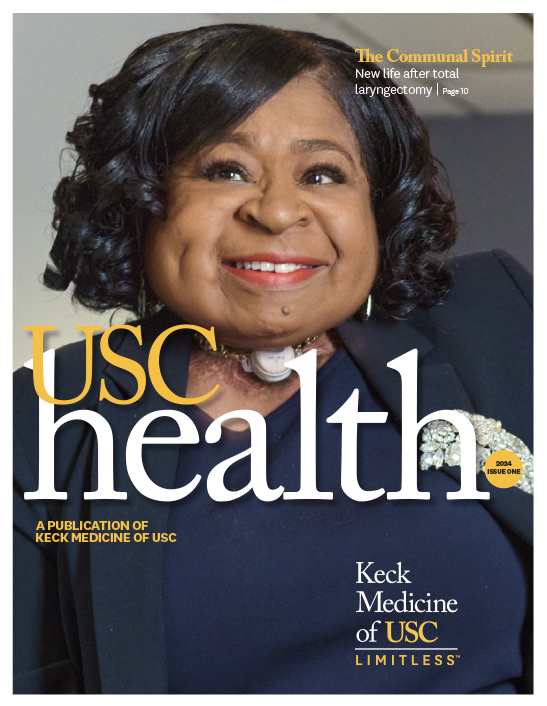
After a lifetime of competitive gymnastics, former national champion Anna Glenn looked to Keck Medicine of USC to get ready for a new routine.
Anna Glenn was just 2 years old when her parents enrolled her and her twin sister in gymnastics class. The pair had recently been adopted from an orphanage in China and had rickets and bowed legs from malnourishment.
Their parents hoped that tumbling would help them build some much needed strength. Little did they know that both girls would not only love gymnastics, but would come to excel in the sport.
Both went on to compete for UCLA, one of the top NCAA Division I gymnastics programs in the country, and became national collegiate champions in 2018.
Becoming an elite athlete requires a rare combination of raw talent, intense commitment and love of competition. Being born with certain physical attributes can also help elevate some people to the highest levels in their given sport.
In Anna’s case, she was born with generalized joint laxity — or loose joints — which means the tendons and ligaments around her joints are more elastic than most people’s, an attribute that can help many athletes excel.
When my arm was hanging by my side, it felt like gravity was pulling it out of the socket.
Anna Glenn, patient, USC Epstein Family Center for Sports Medicine
Pitchers, for example, tend to have loose shoulder joints, which is one of the factors that can help them throw harder and faster than an average person.
For gymnasts, having loose joints helps them generate both the explosive power they need to perform the twists, turns and tumbles in various gymnastics events, and gives them the flexibility to achieve the grace and form associated with the sport.
Unfortunately, her orthopaedic surgeon at Keck Medicine of USC said that having loose joints can also cause athletes to experience more pain and injury over a lifetime. When a large joint such as a shoulder is loose, it moves more and can wear on the surrounding cartilage or ligaments and lead to tears, sprains or dislocations.
Before she had even started her college gymnastics career, Anna had dislocated her shoulder twice. But it was earlier this year while performing a pirouette on the uneven bars that she felt an odd sensation in that shoulder.
Although it did not dislocate that time, it began to cause her pain, even after she officially retired from competitive gymnastics later that spring.
“When my arm was hanging by my side, it felt like gravity was pulling it out of the socket,” Anna remembers, adding that some everyday tasks, like driving, could force her shoulder to lock up. “I started feeling the pulling all the time, and I started to have trouble lifting heavy things.”
Seeking relief from ongoing shoulder pain
Anna made an appointment with a Keck Medicine orthopaedic surgeon to evaluate her shoulder, hoping to find relief from the ongoing pain and the nagging fear that her shoulder might dislocate again.
Her surgeon was part of a team of sports medicine specialists at the USC Epstein Family Center for Sports Medicine, located at the Toyota Sports Performance Center in El Segundo, which also has offices in Beverly Hills, Glendale, Downtown and East Los Angeles.
While her surgeon specialized in treating shoulder, elbow and knee injuries, the team at the USC Epstein Family Center treats all musculoskeletal injuries ranging from sprains and strains to complete joint replacement, when necessary.
The El Segundo location, which opened in 2019, is state of the art and one of a kind. Not only can the team of sports medicine specialists diagnose and treat a range of injuries, patients also can do their rehabilitation in the same location and learn about the best techniques for preventing injury in the future.
There is also important research in the Department of Orthopaedic Surgery at the Keck School in the area of joint preservation, including a new clinical trial assessing a small molecule developed at USC to treat early-stage osteoarthritis of the knee.
If successful, the molecule will be a first-in-class treatment that protects cartilage, tamps down inflammation and may later be tested in other joints.
Another trial is evaluating the efficacy of an oral steroid on hastening recovery and improving strength after rotator cuff repair. Her surgeon noted that the development of these novel biologic therapies is essential to joint preservation and likely will play a central role in future treatment of musculoskeletal disease.
The El Segundo center was built to bring a new, higher level of care to all athletes of all levels and all ages.
The group includes orthopaedic surgeons and an interventional spine care doctor, who provide the broadest range of surgical and non-surgical treatments for orthopaedic injuries and pain and, in most cases, can offer patients non-surgical interventions before surgery.
There are some exceptions, however.
Anna, because she had dislocated her shoulder twice as a teen and had arthroscopic shoulder stabilization surgery both times, was not likely to benefit from physical therapy or medical treatments.
According to her surgeon, once a shoulder has dislocated, it tends to be prone to redislocation; and the younger you are, the more likely you are to dislocate it again.

Long-term solution with open capsular shift
Although most shoulder stabilization surgery is done arthroscopically, Anna considered an older procedure, one that is rarely performed and more complex than arthroscopic procedures, called an open capsular shift.
There is a subset of patients who benefit from open stabilization, according to her surgeon, who explained that athletes experience redislocation up to 20% of the time following arthroscopic shoulder stabilization. With the open procedure, the redislocation rate is much lower — about 5% to 10%.
This procedure also may be indicated in patients who failed a previous arthroscopic procedure, such as Anna.
Anna says she opted to have the open capsular shift surgery because she wanted whichever procedure would give her the best shot at fixing her shoulder once and for all.
The recovery process is going well … I am feeling really confident in the outcome of the surgery.
Anna Glenn, patient, USC Epstein Family Center for Sports Medicine
“I didn’t want to have to deal with this the rest of my life or do rehab for the rest of my life, so I just figured I should get this fixed while I am young,” she says. “[My surgeon] said the open surgery would give me a longerterm result.”
The procedure itself was short and Anna, who had surgery at the end of July, was able to go home the same day.
Within two months, she had incorporated strength exercises into her physical therapy. Now, she continues getting stronger every day.
“The recovery process is going well,” Anna says. “My range is coming back fairly quickly and I am on the way to feeling stronger and healthier. I am feeling really confident in the outcome of the surgery.”
Topics


